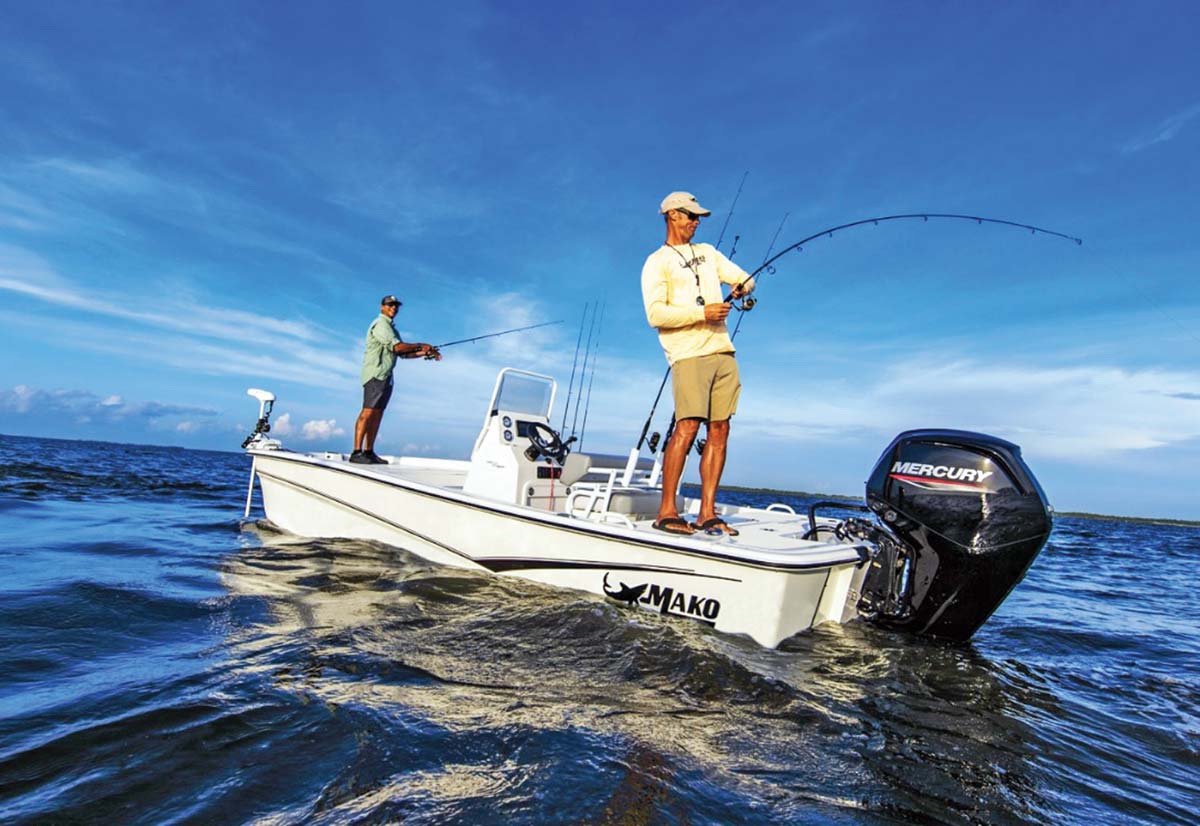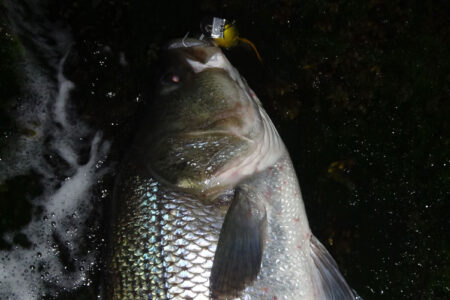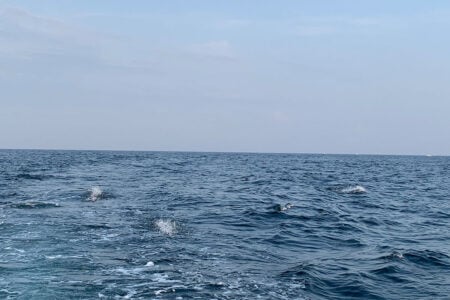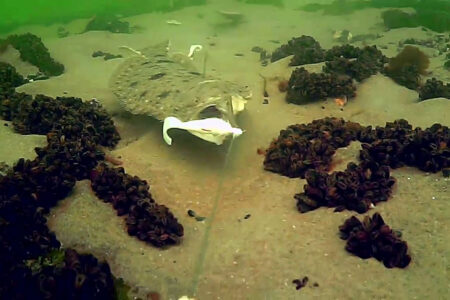
Fifty years of experience coming together to create the perfect skiff.
Many Fisherman readers know me as an avid bluewater angler and charter boat captain that has been heading offshore for the better part of five decades. What you may not know is that I started off my angling life with a basic 19-foot moderate deadrise skiff and still own a trailer-able 18-footer today that I just repowered. For a lot of folks, inshore coastal skiffs meant for quiet backwaters, skinny water bays, inlets and estuaries are an affordable way to give your sport a lot more reach and flexibility at a reasonable entry fee. Let’s take a closer look at why inshore skiffs are still relevant today and can be the “right choice” for getting into the boating game. We’ll also take a deeper dive into how to trick yours out to be a totally awesome fishing machine.
So What’s A Skiff?
My definition of a skiff is an open layout, moderate deadrise, outboard-powered, trailer-able hull that ranges in size from 15 to 19 feet in length. They can be made out of wood, glass over wood, aluminum or fiberglass, with the latter two materials the most popular in 2023. To be true to the “get back to basics” concept of the typical skiff, T-Tops and hardtops are out of the picture, so you will experience nature in its all-natural form, as the Vikings and early Pacific Islanders did.
Skiffs can range from relatively lightweight aluminum craft with short (15-inch) or long (20-inch) outboard shaft lengths, or fiberglass models that can accommodate either long or extra-long (25-inch) outboards like my 1999 EdgeWater 185cc. The deeper transoms and gunnels on some of the 17- to 19-foot boats provide added leg support and seaworthiness when plying spacious bays where an afternoon wind chop can create an incessant cadence of short, choppy waves, or inlets where you might experience a serious wind-against-tide situation. Some skiffs like the smaller 15- to 17-footers might feature portable fuel tanks, whereas others offer the convenience, safety and extended range of internal tankage.
Hull designs of the typical coastal skiff can range from flat bottoms (like some Carolina Skiffs, tin boats and John/Amesbury Dories) to moderate aft deadrise angles that can approach 6 degrees, 12 degrees (like my original Aquasport 19 CC), or a max of 16 degrees of aft vee-angle (like my current EdgeWater 185cc). The rule of thumb for most of these open skiffs is the deeper the deadrise, the more horsepower you will need to keep it up on plane. Sixteen-foot dory types like those manufactured by Duxbury, John Dory, Stur-Dee’s Amesbury Dory and others can get by with minimal powerplants in the 20 to 25 HP range, with 15-foot aluminum boats doing just fine with man-portable outboards from 8 to 15 HP.
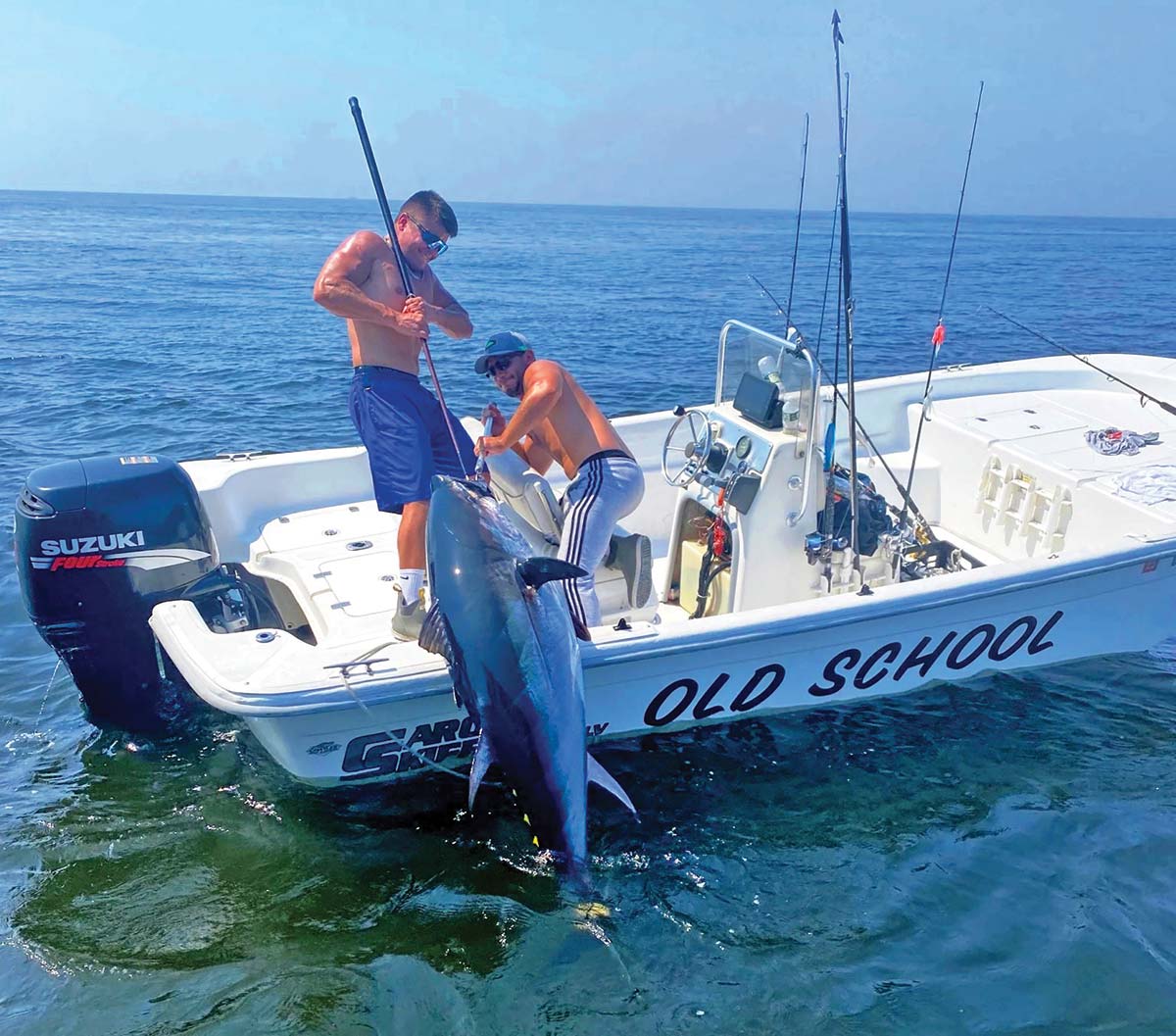
The Basics
When I acquired my original 1979 Aquasport 19CC, I didn’t know a thing about what makes a good skiff come to life as a viable sport fishing and family entertainment platform. It had two seats, a center console, a 45-gallon fuel tank and a 100 HP Johnson V4 two-stroke, a place to throw some safety gear under the console and that was about it. It was bereft of a fishbox, livewell and dedicated tackle storage. All of the marine electronics, like a Si-Tex Loran-C navigator, Lowrance paper graph sounder and marine VHF were competing for precious space mounted on top of a smallish console dash, outfitted with a modest Ritchie compass. She was all I could afford and I was proud of her, caught my first mako (279 pounds) and bluefin tuna (35 pounds) with her, and for three years this basic 19-foot open skiff enabled me and my growing family of a wife and two young boys to enjoy the water with a limited budget. Looking back, I was young and foolish and would advise my younger self against pressing the envelope like I did with this skiff.
Based on what I knew then and currently know now with four decades of boat testing under my deck shoes, I would do things differently and know exactly what to look for to shape the ultimate skiff for my remaining days. In fact, I have already done just that and it comes in the form of the 1999 EdgeWater 185cc that I bought used back in 2016 for my two sons and their families, so that they could pass on the beauty of the coastal “skiff life” to their children. So what are the critical things to look for when getting and shaping your ultimate skiff?
The requisite items for any utility skiff should include a place to put a marine battery, fuel tank, safety gear, tool kit, fishing rods and tackle. Sure, there’s a bunch of other stuff that will make your trip out there and back considerably more comfortable and user-friendly, but what you add is all a function of skiff size, dedicated onboard storage space, people capacity, engine size, fuel capacity and your allotted budget to make things happen.

Next Level Skiff
Based on my many hundreds of historical boat tests and reviews I had identified a handful of boats, that if they become available on the used market and I had the money, I would jump on them if the planets were in alignment. I own two of those boats now in the form of my 2006 EdgeWater 228cc that is my everyday bay, sound and ocean charter boat, plus the aforementioned 1999 EdgeWater 185cc that I bought for my sons and grandkids. The 185cc is unique in that former Whaler SVP of Engineering, Bob Dougherty designed this boat for his startup EdgeWater Boats in the mid-90s, to perfect the “skiff life” concept, plus a whole lot more. So what are some of the desirable items that separate this skiff and others like her from the rest of the pack?
To answer that question, and to offer a guide for the things to look for when creating or updating your own fishing skiff, I’ve detailed a short list of specifications that are built into my EdgeWater 185cc that might be something to think about for yours:
Built-in 20-gallon recirculating livewell under the leaning post/rocket launcher
Seating for six (two aft jump seats, two at the helm, two on forward cooler
54-gallon fuel tank
Tackle storage under port aft jump seat
Twin batteries with 4-way switch under starboard aft jump seat
Two flush-mount, seven vertical and six horizontal rod holders (15 total)
Raw water washdown
Storage under the console for access to safety gear, tools, PFDs and wiring
Storage box under the helm for sunglasses, sunscreen, first aid kit and cell phones
Tilt-helm with no-feedback heavy duty cable steering
Twin breaker panels for electronics and accessories
Storage space under the leaning post for spools of line, air horn, washdown hose and other sundries
Removable 94 quart Igloo Marine Grade cooler with cushioned bench seat and backrest
Raised forward casting deck with anchor storage down under
Starboard ½-swim platform to port with telescoping stainless steel boarding ladder
Stainless steel grab rail around console and forward high-profile bow rail
Room on dash top for Furuno GP1870F chartplotter/echo sounder, Ritchie SS-1002 compass, twin cup holders, Standard-Horizon VHF radio and ProSpec AM/FM/Bluetooth Stereo
The EdgeWater 185cc came standard with most of these skiff features built-in from the get go, such was the creative genius and vision of engineer/designer Bob Dougherty and many of the boats he built at Boston Whaler, EdgeWater and his final stop at Everglades. I added the triple vertical rod rack that is attached to removable transom wave gate and swapped out the original rod holders that drained down into the bilge for a pair of Perko capped units that preclude this nuisance. The electronics suite was all added onboard after I bought her, as was the 12-volt Blue Seas electrical panel to run the new multifunction display, VHF and marine stereo. A new Shakespeare Galaxy model 5225, 8-foot antenna VHF antenna was part of my minimal upgrades, as was a small VHF antenna. The Ritchie SS1002 blue card compass was a necessary replacement for the original compass that had seen better days. I also replaced the original Teleflex cable steering with the latest Seastar/Teleflex no-feedback system, complete with a convenient tilt-helm which molds itself to the size and shape of each driver.
I replaced the original Yamaha S130 V4 two-stroke outboard with a Mercury 115 ProXS back in 2018 and did a repeat of that operation with a new Merc 115 ProXS in June of this year. Rigged accordingly and spinning an Enertia 14.7 x 18 three-blade S/S prop, she’ll hit a top speed of 36.5-knots at wide open throttle with two adults aboard and dial down to a 24-knot cruise at 4400 rpm, burning 5.9-gph and getting a solid 4.1 nautical miles per gallon. All of which is a perfect segue to our next topic, skiff performance.

Skiff Performance
The seaworthiness and performance aspects of each skiff will vary greatly and is based on boat size and weight, the amount of people/gear onboard, hull design and the amount of horsepower on the transom. There are myriad nuances for open skiffs in the 15- to 19-foot range that will determine how fast and how far you can run, how much of a load you can carry and how comfy it will be when in transit.
For example, a 15-foot Linder aluminum boat outfitted with a 25-HP four-stroke Yamaha outboard will hit a top speed of approximately 24 knots at about 3 gph, for a net of roughly 8 NMPG. If you have a six-gallon portable tank onboard, that translates to a range of 45 nautical miles with a small reserve. You are already versed on how my EdgeWater 185cc will perform with its Merc 115 ProXS.
One of the things that I’ve learned with driving skiffs for the better part of 50-years is that they are all different and each has its quirks on any given day, depending on how much water you need to cover, the number of people onboard, along with the local wind and sea conditions. As the old mariner’s axiom states, “you have to pick your days”. After driving the EW 185cc in the eastern Long Island Sound, the Peconics and traversing through Shinnecock Inlet to head to the reef and travel along the beaches looking for bunker, I have come to realize that this skiff is great in the inlet and back bay areas, can tolerate the open water of the eastern sound and will run in the rough stuff when she has to, relatively dry and comfortable. My ocean trips have proven to me that her modest cockpit depth of 20-inches aft and 21-inches amidships is not ideal for someone who is six-feet, three-inches tall when exposed to the usual pitch, roll and yaw motions of the ocean…you always need a free hand to hold onto something.
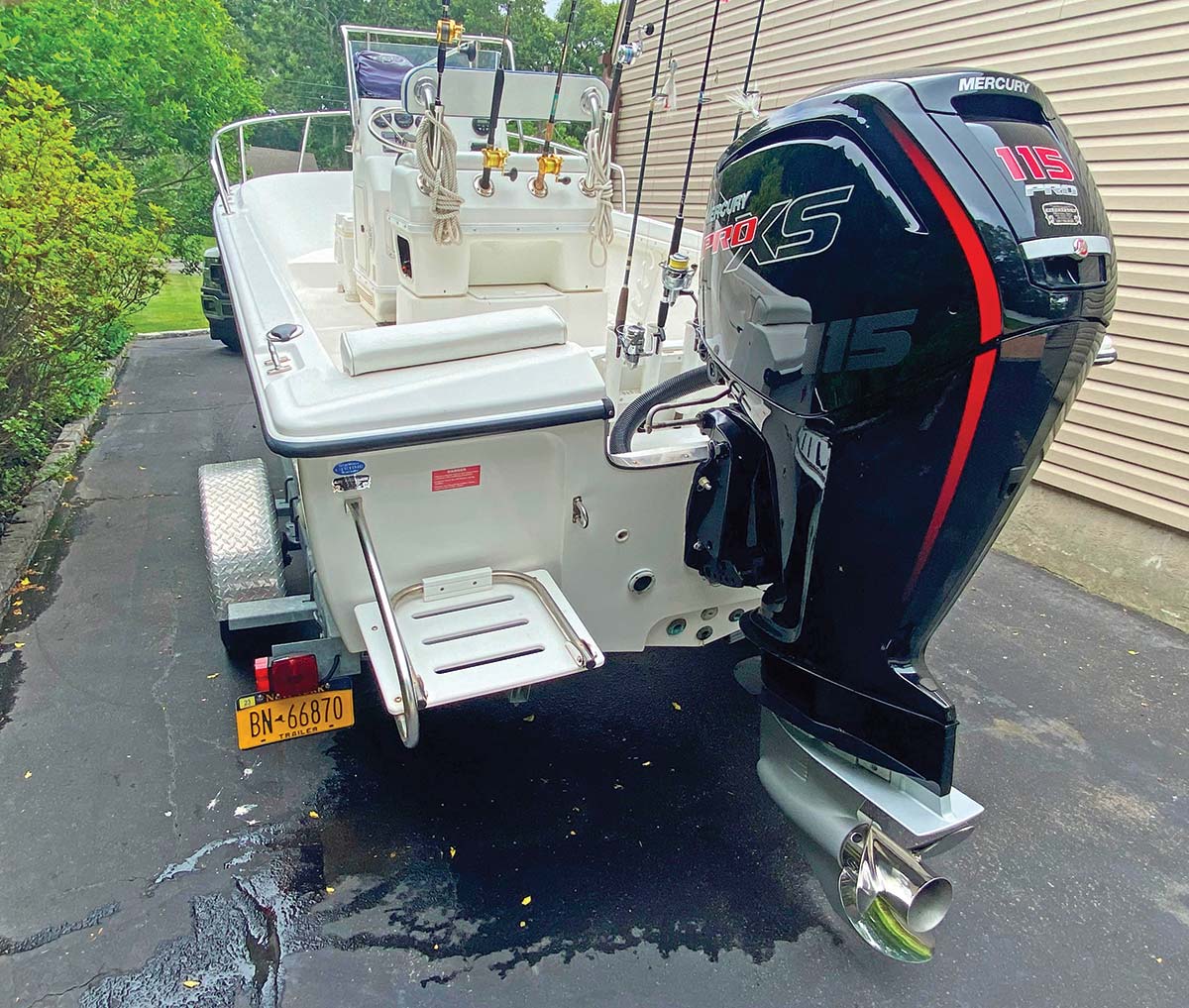
Some Final Thoughts
Skiffs are way cool and a great way to bring family and friends together without breaking the bank. They are a perfect vehicle to create memories of adventures to the sun, sand and surf with your children that will last a lifetime, from crabbing, to digging clams and bending the rods on cooperative juvenile species like weakfish, fluke, bass and bluefish. As noted anglers like John Skinner and others have demonstrated in their books and YouTube videos, you can trailer a 16-foot aluminum skiff to a variety of places and catch a whole bunch of trophy-sized coastal gamefish. Anything that’s not built-in to some of the smaller skiffs, like iced storage for your food and drinks, or tackle storage for the day’s main event, can typically be carried onboard as you need it via waterproof travel cases.
The main concepts to keep in the forefront when talking about coastal skiffs is to keep it simple, keep it affordable and keep it safe. It’s supposed to be a fun experience. To quote Joni Mitchell from her original song Woodstock that was popularized by CSN&Y back in the early 1970s, “I want to get back to the land and set my soul free”, which is the essence of skiff life, from putting around with the kids, clamming, beaching it or bending rods. Enjoy the salty life and be safe out there.
